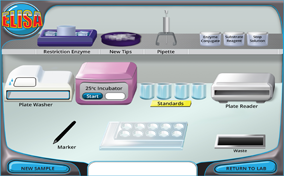What is ELISA?
ELISA stands for enzyme-linked immunosorbent assay, which is a laboratory tool commonly used in diagnostic medicine. ELISA can detect the presence of various antigens or antibodies that might indicate Lyme disease, HIV, or pregnancy. ELISA can also be used to test a patient's blood or urine for illicit drug use.
How does general ELISA testing work?
In general ELISA testing, either an antigen or antibody is bound to the wells of a polystyrene plate. In drug testing for fentanyl, an antibody is bound to the plate, while in HIV testing, an antigen is bound to the plate. In testing for HIV, after the antigen has been added to the wells, the patient's serum is added to the well. If the serum contains the HIV antibodies, the antibodies attach to the antigen bound to the well walls. A second antibody is added to detect the antigen-antibody complex attached to the walls. The wells are then washed with a buffered solution to remove any unbound antigens. A chromogenic enzyme is then added to react with the secondary antibody, which produces a color change in the solution. The antibody concentration in the solution is directly proportional to the solution's color intensity.
What is fentanyl?
Fentanyl is around 50 times more potent than heroin and about 100 times more powerful than morphine. Even a dose as small as 2 milligrams, which is just a little bit more than the mass of a flea, can be fatal. Fentanyl is a synthetic opioid used to reduce pain. Fentanyl also produces feelings of euphoria and, for this reason, is a much-often abused drug. The highly addictive narcotic has side effects of nausea, vomiting, and severe respiratory distress. Fentanyl and other opioid overdoses have resulted in a steadily rising number of required hospitalizations since 2004 and have accounted for an average of 17,000 deaths annually from 2010-2016.
How does ELISA testing for fentanyl work?
Patient blood or urine can be tested for the presence of fentanyl. In the test, a specific antibody is attached to a polystyrene plate. The antibody responds and reacts with a specific antigen to produce a certain solution color. When the patient's urine sample is added to the plate, any fentanyl in the urine sample binds to the antibody more rapidly and effectively than the added antigen. An enzyme conjugate is added that binds to the antibody-antigen complex. When a substrate reagent and colorizing reagent (called a stop reagent) are added, the binding of the fentanyl with the antibody produces a different color of solution than that of the antigen bound to the antibody and the substrate.
How is an ELISA-tested fentanyl sample evaluated?
The amount of fentanyl in a patient's urine sample affects the color of the bound antibody. A plate reader is often used to measure the color and absorbance of the solution. The normal deep yellow color of a sample with no fentanyl reflects that of the bound antibody-antigen and a high absorbance. The concentration of fentanyl in a patient's urine sample is inversely proportional to the absorbance of the solution. Therefore, as the concentration of fentanyl in a sample increases, the absorbance of the plate reader decreases, which produces a more colorless solution. High plate reader absorbance is associated with a lower concentration of fentanyl in the sample, while low plate reader absorbance is associated with a higher concentration of fentanyl in the sample.
 ELISA stands for enzyme-linked immunosorbent assay, which is a laboratory tool commonly used in diagnostic medicine. ELISA can detect the presence of various antigens or antibodies that might indicate Lyme disease, HIV, or pregnancy. ELISA can also be used to test a patient's blood or urine for illicit drug use. In this activity, you will test a urine sample for the presence of one of the most dangerous drugs, fentanyl. Make sure to put on your virtual protective gear for this test because even a tiny amount of fentanyl can cause major problems.
ELISA stands for enzyme-linked immunosorbent assay, which is a laboratory tool commonly used in diagnostic medicine. ELISA can detect the presence of various antigens or antibodies that might indicate Lyme disease, HIV, or pregnancy. ELISA can also be used to test a patient's blood or urine for illicit drug use. In this activity, you will test a urine sample for the presence of one of the most dangerous drugs, fentanyl. Make sure to put on your virtual protective gear for this test because even a tiny amount of fentanyl can cause major problems.

